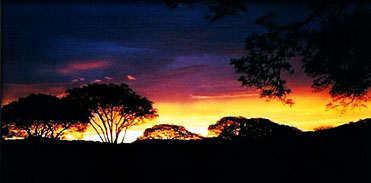You won’t find it on a tourist map, but maybe it’s better that way.
 Nestled in the mountains just 10 miles south of the Etosha National Park is 20,600 acres of real Namibia. Here you will find a wild and free version of Africa that has managed to escape all traces of Disneyfication. A varying landscape of mist-capped mountains, dense forests and rock-strewn hills set the stage for a host of players from the wildlife arena.
Nestled in the mountains just 10 miles south of the Etosha National Park is 20,600 acres of real Namibia. Here you will find a wild and free version of Africa that has managed to escape all traces of Disneyfication. A varying landscape of mist-capped mountains, dense forests and rock-strewn hills set the stage for a host of players from the wildlife arena.
Capture the essence of the tiny, delicate Damara dik-dik, one of the world’s smallest antelope, or witness the awesome power of the mighty eland, the largest and heaviest antelope in the world. A morning stroll or an afternoon vigil at the water hole will reveal a diversity of bird species that is certain to astound even the most avid orinthologist! A leisurely night drive through the world of the bouncing bushbaby, the secretive genet, the rustling porcupine, and the magnificent Leopard will create memories you can treasure long after you’ve returned home.
Sense of Place.
 Like most farms in the region, the Tambuti Wilderness was once a fenced cattle ranch. Drought, leopards, and cheetahs proved to be too much for the cattle, and Mother Nature eventually reclaimed what was hers. As a result, Tambuti is one of the few remaining areas that retains its wild character, which wilderness circles refer to as its “sense of place”.
Like most farms in the region, the Tambuti Wilderness was once a fenced cattle ranch. Drought, leopards, and cheetahs proved to be too much for the cattle, and Mother Nature eventually reclaimed what was hers. As a result, Tambuti is one of the few remaining areas that retains its wild character, which wilderness circles refer to as its “sense of place”.
The History of Namibia – Bushmen, Blood and Jewels.
 Cave paintings that may be more than 25,000 years old attest to the presence of hunter-gatherer groups in the country during the late Pleistocene Period, but the earliest identifiable inhabitants are the San (pictured at right), who were here by the beginning of the 1st century A.D.
Cave paintings that may be more than 25,000 years old attest to the presence of hunter-gatherer groups in the country during the late Pleistocene Period, but the earliest identifiable inhabitants are the San (pictured at right), who were here by the beginning of the 1st century A.D.

These are the people made famous by the movie “The Gods Must Be Crazy” which was filmed on location in Namibia. The Nama-speaking Khoikhoi arrived about 500 A.D. The Ovambo and the Herero migrated to the area much later.
Between a landing by Portuguese explorer Bartolomeu Dias in 1488 and the creation of German South-West Africa in 1884, most of the few Europeans who visited the territory were explorers, missionaries, and hunters. The next three decades of German rule were marked by bloody suppression of the rebellious black Africans, notably the once dominant Herero (Following World War I, Namibia was officially occupied by South Africa until December 1988, when it agreed to allow Namibia to become independent in exchange for the removal of Cuban troops from neighboring Angola.
The constitution of 1990 established Namibia as an independent democratic republic.Herero chieftan pictured at left), whose revolt in 1904 was not finally crushed until four years later at the cost of perhaps 60,000 lives.
Africa’s Jewel.
Namibia has some of the richest diamond fields in the world. Nearly all diamonds extracted are of gem quality. Gem-quality diamond output in 2000 was 1.5 million carats.
A Proud People.

With a population of roughly two million, Namibia has plenty of space to enjoy. Black Africans constitute about 86 percent of the population of Namibia; whites, about 6.6 percent; and people of mixed descent, about 7.4 percent. The principal nonwhite group is the Ovambo, an agricultural people who live primarily in the north and make up about one-half of the population. The Ovambo speak a Bantu language.
 Other nonwhite groups include the Kavango, the Herero, the Damara, the Khoikhoi, and the San Bushpeople. English is the official language, but Afrikaans and German are widely spoken. In addition, each African ethnic group has its own language.
Other nonwhite groups include the Kavango, the Herero, the Damara, the Khoikhoi, and the San Bushpeople. English is the official language, but Afrikaans and German are widely spoken. In addition, each African ethnic group has its own language.
The white population and a majority of the black population are Christian; the remainder mostly adheres to traditional faiths.
Ready to visit the Tambuti Wilderness or just want to learn more? Contact Us!
